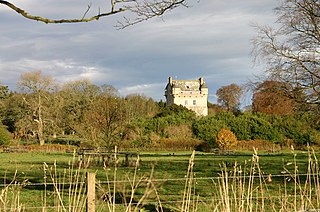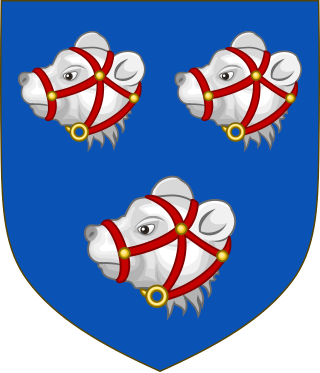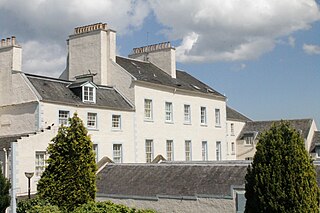

Pitmedden Garden is a garden in the town of Pitmedden, Aberdeenshire, Scotland. It is owned by the National Trust for Scotland. [1] It is the largest surviving parterre in Scotland and dates from around 1675. [2]


Pitmedden Garden is a garden in the town of Pitmedden, Aberdeenshire, Scotland. It is owned by the National Trust for Scotland. [1] It is the largest surviving parterre in Scotland and dates from around 1675. [2]
The garden is noted for its geometric parterres which vary in shape from a thistle to Sir Alexander Seton's coat of arms. Pitmedden also has several long, varied borders which run along the garden walls. Sir Alexander Seton and Dame Margaret Lauder, his wife, established a house and garden at the site in 1675. [3] The original house, together with the garden plans, was largely destroyed by fire in 1807. [4]
The 20th century restoration based three parterre sections on the 1647 plan of Holyrood Palace by Gordon of Rothiemay, and the fourth section represents a memorial to Alexander Seton and his father John Seton. [5]

Balmoral Castle is a large estate house in Aberdeenshire, Scotland, and a residence of the British royal family. It is near the village of Crathie, 9 miles (14 km) west of Ballater and 50 miles (80 km) west of Aberdeen.

Clan Gordon is a Highland Scottish clan, historically one of the most powerful Scottish clans. The Gordon lands once spanned a large territory across the Highlands. Presently, Gordon is seated at Aboyne Castle, Aberdeenshire. The Chief of the clan is the Earl of Huntly, later the Marquess of Huntly.

Barncluith is an area of Hamilton in South Lanarkshire, Scotland. Barncluith forms the south-eastern part of the town, between the urban centre and the Avon Water. It lies either side of Carlisle Road (A72), which leads out of Hamilton to Chatelherault Country Park, Larkhall and the Clyde Valley. The name derives from "Baron's Cleugh", a cleugh being a ravine.

Aden Country Park is located in Mintlaw, Aberdeenshire, Scotland, first mentioned in the 10th-century Book of Deer. The park has a caravan area with camping, a small shop, a small cafe near the agricultural museum, a play area, the maintained ruins of Aden House, landscaped gardens, and a barbecue area. Aden Park can be accessed from Mintlaw by Station Road or Nether Aden Road.

Pitmedden is a rural village in the parish of Udny, Aberdeenshire, Scotland, situated midway between Ellon and Oldmeldrum, and approximately 16 miles (26 km) distant from Aberdeen. In addition to local shops, primary school, church, village hall and parks, the village is home to Pitmedden Garden, originally created in the 17th century by Sir Alexander Seton and gifted to the National Trust for Scotland in 1952, and the Formartine United Football Club.
Sir Alexander Seton of Pitmedden, 1st Baronet, Lord Pitmedden was a Scottish advocate, a Senator of the College of Justice, a Lord of Justiciary, and a Commissioner.

Balcaskie is a 17th-century country house in Fife, Scotland. It lies around 2 km north of St Monans, and is notable chiefly as the home and early work of architect Sir William Bruce.

Udny Green is a village in Aberdeenshire, Scotland, immediately southwest of Pitmedden. It is part of the parish of Udny along with another small settlement, Udny Station. Udny Parish Church is located beside the village green with the old kirkyard and Udny Mort House on the opposite side.
There have been four baronetcies created for persons with the surname Seton, all in the Baronetage of Nova Scotia. As of 2008 one creation is extant, one dormant and two extinct.

Cairnbulg Castle is a z-plan castle situated in Cairnbulg, Aberdeenshire, Scotland. It was described by W. Douglas Simpson as one of the nine castles of the Knuckle, referring to the rocky headland of north-east Aberdeenshire. It stands by the River Philorth and was originally known as Philorth Castle. The 17th-century Philorth Castle, an L-plan house consisting of a sizeable crow-stepped block, was demolished after a fire in 1915.

Clan Forbes is a Highland Scottish clan from Aberdeenshire, Scotland.

Panmure House was a 17th-century country house in the Parish of Panbride, Angus, Scotland, 4 miles (6 km) to the north of Carnoustie. It was the seat of the Earl of Panmure. It was rebuilt in the 19th century, and demolished in 1955.

Kincardine Castle is a Victorian country house in Royal Deeside, Scotland. Formerly known as Kincardine House, it is a private home of Andrew Bradford and also operates as a hospitality venue. The house sits 1 kilometre (0.62 mi) north-east of the village of Kincardine O'Neil, and 8 kilometres (5.0 mi) east of Aboyne on the north side of the River Dee, Aberdeenshire.

Yester House is an early 18th-century mansion near Gifford in East Lothian, Scotland. It was the home of the Hay family, later Marquesses of Tweeddale, from the 15th century until the late 1960s. Construction of the present house began in 1699, and continued well into the 18th century in a series of building phases. It is now protected as a category A listed building, and the grounds of the house are included in the Inventory of Gardens and Designed Landscapes in Scotland, the national listing of significant gardens.

Penicuik House survives as the shell of a formerly grand estate house in Penicuik, Midlothian, Scotland. The 18th-century palladian mansion was built on the site of an earlier house by Sir James Clerk, 3rd Baronet. It was destroyed by fire in 1899 and a major restoration was completed in 2014 by G Brown Stonemasons.

Westhall Castle, also known as Westhall House, is a country house located to the north of Oyne, in Aberdeenshire, Scotland. The house includes a 16th-century L-plan tower house, which was substantially extended in the 17th and 19th century. The house is a category A listed building.

Barra Castle is an unusual L-plan tower house dating from the early 16th century, about two miles south of Oldmeldrum, above the Lochter Burn, in the parish of Bourtie, Aberdeenshire, Scotland. It occupies the site of the Battle of Inverurie (1308), in which Robert Bruce defeated John Comyn, Earl of Buchan.

Hatton Castle is almost three miles (4.8 km) south-east of Turriff, Aberdeenshire in the north-east of Scotland. Formerly known as Balquholly Castle, sometimes spelt as Balquollie, it was renamed in 1814. The 17,994 square feet (1,671.7 m2) mansion was designated a category A listed building in 1972; the gardens are included in the Inventory of Gardens and Designed Landscapes in Scotland.
Before the Acts of Union 1707, the barons of the shire of Aberdeen elected commissioners to represent them in the unicameral Parliament of Scotland and in the Convention of the Estates. The number of commissioners was increased from two to four in 1690.

Whitefoord House (or occasionally Whiteford House is an 18th-century former mansion on the Canongate section of the Royal Mile in Edinburgh. It stands on the north side of the Royal Mile obscured by more modern buildings, under a backdrop of Calton Hill.
Coordinates: 57°20′35″N2°11′31″W / 57.34306°N 2.19194°W